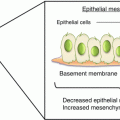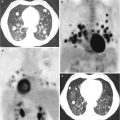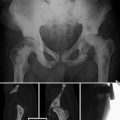Fig 15.1
Mechanism of action of bisphosphonate, denosumab, and anti-androgen on the bone metastases “vicious cycle.” OCLs osteoclasts, OBLs osteoblasts
The efficacy of bisphosphonate treatment on patients with bone metastatic cancer depends on the specific bisphosphonate and on the administered doses (Table 15.1). In a combined analysis of two placebo-controlled studies of 378 men with metastatic prostate cancer, pamidronate (90 mg every 3–4 weeks) failed to demonstrate a significant overall treatment benefit compared to placebo in terms of reduction of SREs and palliation of bone pain [50]. In particular, Small et al. did not observe sustained or significant differences between the pamidronate and placebo groups for self-reported pain, analgesic use, or mobility [50]. In a double-blind placebo-controlled randomized trial, clodronate did not improve bone progression-free survival (BPFS) among men with bone metastases from prostate cancer. Heidenreich A et al. showed that clodronate treatment (300 mg for 8 days) of painful osseous metastases due to hormone-refractory prostate cancer resulted in a significant pain decrease with a concomitant reduction in the daily consumption of analgesics in 75 % of patients [16]. Similarly, ibandronate (6 mg over 1 h each day for 3 days followed by a single infusion of 6 mg every 4 weeks) showed a significant improvement in bone pain in patients with hormone-refractory prostate cancer and bone metastases [15]. Zoledronic acid is the most potent bisphosphonate currently used in men with bone metastatic prostate cancer that has progressed after initial hormone therapy. The benefit of zoledronic acid (4 mg every 3 weeks) was demonstrated in a randomized, placebo-controlled trial in patients with hormone-refractory metastatic prostate carcinoma. This study showed a significant reduction in the frequency of SREs, a longer median time to develop SREs, and lower pain and analgesic scores [44]. In particular, a greater proportion of patients who received placebo had SREs than those who received zoledronic acid at 4 mg (44.2 % versus 33.2 %); median time to first SRE was 321 days for patients who received placebo and was not reached for patients who received zoledronic acid at 4 mg. In a subsequent placebo-controlled randomized clinical trial, zoledronic acid reduced the incidence of SREs (38 % versus 49 % for the placebo group) in men with hormone-refractory metastatic prostate cancer. Moreover, zoledronic acid increased the median time to the first SRE (488 days versus 321 days in the placebo group) and reduced the ongoing risk of SREs by 36 % compared with placebo [45]. Further evidence of zoledronic acid efficacy in preventing bone fractures was demonstrated in a randomized phase III trial (RTOG 0518) in patients with high-grade and/or locally advanced, nonmetastatic prostate adenocarcinoma receiving luteinizing hormone-releasing hormone (LHRH) agonist and radiotherapy (RT). Data showed that zoledronic acid treatment was associated with improved bone mineral density (BMD) [21]. Similar results were obtained in another study that showed an increase in BMD and a durable suppression of serum N-telopeptide levels for 12 months in men receiving a gonadotropin-releasing hormone (GnRH) agonist in combination with zoledronic acid [29].
Table 15.1
Summary of main randomized controlled trials evaluating in men with prostate cancer
N° of patients/primary cancer | Scheduling | Study | Results | References |
|---|---|---|---|---|
Clodronate | ||||
Hormone refractory metastatic prostate cancer | 3 mg i.v. for 8 days | Open, uncontrolled study | Significant decrease in bone pain score in 75 % of patients (p < 0.001) | 8 |
Ibandronate | ||||
Hormone refractory metastatic prostate cancer | 6 mg i.v. on days 1-3 then 6 mg every 4 weeks | Open, uncontrolled study | 92 % of patients had significant pain reduction, and 39 % of patients were completely pain free | 9 |
Pamidronate | ||||
Hormone refractory metastatic prostate cancer | 90 mg i.v. every 3 weeks for 27 weeks | Double-bind, placebo-controlled trial | No significant or sustained effect o pain score | 7 |
Zoledronic acid | ||||
Hormone refractory metastatic prostate cancer | 4 or 8 mg i.v every 3 weeks for 15 months | Double-bind, placebo-controlled trail | SRE incidence reduction (44.2 % placebo group vs 33.2 % ZA group) and significant decrease in bone pain and analgesic use | 10 |
Hormone refractory metastatic prostate cancer | 4 or 8 mg i.v every 3 weeks for 15 months | Double-bind, placebo-controlled trail | SRE incidence reduction (38 % placebo group vs 49 % ZA group) and median time to first SRE increase (321 days placebo group vs 488 days ZA group) | 11 |
Nonmetastatic prostate cancer | 4 mg i.v. every 6 months | Randomized placebo-controlled trial | BMD improvement in ZA group compared to placebo: lumbar spine (6 % vs 5 %), left total hip (1 % vs 8 %) and left femoral neck (3 % vs 8 %) | 12 |
Nonmetastaticprostate cancer | 4 mg i.v. only in day 1 | Randomized controlled trial | BMD improvement in ZA group compared to placebo in lumbar spine and in total hip | 13 |
Nonmetastatic prostate cancer | 4 mg i.v. every 3 months | Randomized controlled trial | BMD improvement in ZA group compared to placebo in lumbar spine, femoral neck, and in trochanter and total hip | 14 |
High-risk, locally advanced, metastatic or recurrent prostate cancer | 4 mg for six 3-weekly cycles, then 4-weekly in combination with docetaxel 75 mg/ml (six 3-weekly cycles) + prednisolone 10 mg daily | Randomized controlled trial | No improvement in overall survival in ZA group or delay in SRE | 15 |
Castration-sensitive metastatic prostate cancer | 4 mg i.v. every 4 weeks | Double-bind, placebo-controlled trial | Early ZA treatment did not increase time to first SRE (median time 31 months in ZA group vs 29,8 months in placebo group) | 16 |
In the adjuvant setting of hormone-sensitive prostate cancer, zoledronic acid can be given to prevent and treat tumor therapy-induced bone loss. A randomized phase III trial demonstrated that this agent increased bone density in patients with nonmetastatic prostate cancer receiving androgen deprivation therapy (ADT) [51]. Data showed that lumbar spine bone mineral density increased 5.6 % from baseline in 1 year in the zoledronic acid group and decreased 2.2 % in the placebo group (mean difference 7.8 %). Bone mineral density significantly increased from baseline also in the femoral neck, trochanter, and total hip [51]. Currently, the key question is what is the role of zoledronic acid in hormone-sensitive prostate cancer? In the STAMPEDE trial, the addition of zoledronic acid to docetaxel did not improve survival outcomes or delay the SRE incidence [20]. In the CALGB/ALLIANCE 90202 study comparing early treatment in hormone-sensitive prostate cancer versus delayed treatment in castration-resistant prostate cancer (CRPC), no difference in SRE-free survival and no change in survival outcomes were noted. Thus, zoledronic acid did not improve SRE in hormone-sensitive disease (median time to first SRE was 31.9 months in the zoledronic acid group and 29.8 months in the placebo group) [53].
15.2 Denosumab
Bone metabolism is a dynamic process that balances bone formation and bone resorption. Bone resorption is performed by active osteoclasts, while bone formation implies inhibition of bone-resorbing activity and stimulation of osteoblast bone deposition [25]. The receptor activators of nuclear factor-kappaB ligand (RANKL)/RANK/osteoprotegerin (OPG) are members of the TNF and TNF-receptor superfamily and act as essential mediators of OCL formation, function, and survival. RANKL normally secreted by osteoblast binds to its receptor RANK, which is expressed by precursors and mature osteoclasts, stimulating bone resorption activity; in contrast, OPG, the decoy receptor for RANKL, prevents osteoclast activation [10]. In addition to its role as a regulator of bone remodeling, the RANKL/RANK/OPG network also has a key role in osteolytic bone metastasis [10]. The morphometric analysis of immunohistochemical staining showed that RANK, OPG, and RANKL were not significantly expressed in hyperplastic prostate, while their expression levels were increased 50, 45, and 52.5 %, respectively, in prostate cancer tissue [23]. Understanding the molecular mechanisms that trigger the vicious cycle of bone metastases has provided potential targets such as the RANKL/RANK pathway. It has proven to be an effective target for translational research due to its central role in the cascade of events leading to metastatic bone disease. Indeed it has been demonstrated that RANK expression level in the primary tumor correlated with the occurrence of bone metastases, and RANK-expressing cancer could be found in up to 80 % of bone metastases originating from solid tumors [27, 47], suggesting that RANK enables cancer cells to migrate to bone where RANKL is abundantly expressed by osteoblasts. Furthermore, RANKL was also able to directly induce prostate cancer cell proliferation increasing this vicious cycle [30] (Fig. 15.1). Recent evidence suggests an important role for RANKL/RANK in the immune system including in lymph node development, lymphocyte differentiation, dendritic cell survival, T-cell activation, and tolerance induction.
Denosumab (AMG162) is a human non-cytotoxic IgG2 monoclonal antibody with an extremely high affinity and specificity for human RANKL. It is approved for the treatment of osteoporosis, cancer treatment-induced bone loss, bone metastases, and other skeletal pathologies mediated by osteoclasts [22]. Several clinical trials demonstrated the ability of denosumab to prevent the development of bone metastasis in high-risk prostate cancer patients (Table 15.2).
Table 15.2
Summary of main randomized controlled trials evaluating denosumab in men with prostate cancer
N° of patients/primary cancer | Scheduling | Study | Results | References |
|---|---|---|---|---|
Denosumab | ||||
Bone metastatic castration resistant prostate cancer | 120 mg subcutaneous denosumab plus intravenous placebo, or 4 mg intravenous zoledronic acid plus subcutaneous placebo every 4 weeks | Multicenter, double-blind study, randomized | Median time to first SRE was 20.7 months with denosumab compared with 17.1 months with zoledronic acid | 24 |
Nonmetastatic castration resistant prostate cancer | Denosumab 120 mg or subcutaneous placebo every 4 weeks | Double-blind, randomized, placebo-controlled study | Denosumab significantly increased bone-metastasis-free survival by a median of 4.2 months compared with placebo | 25 |
Nonmetastatic hormone-sensitive prostate cancer receiving androgen-deprivation therapy (ADT) | Denosumab at a dose of 60 mg subcutaneously every 6 months or placebo | Double-bind, multicenter study | BMD of the lumbar spine had increased by 5.6 % in the denosumab group as compared with a loss of 1.0 % in the placebo group | 26 |
In a randomized double-blind phase III study of castration-resistant prostate cancer patients with bone metastases, the median time to first SRE for the denosumab arm was significantly prolonged (21 months) compared to the zoledronic acid arm (17 months) with no improvement in OS or progression of disease [12]. In particular, 1904 patients were randomly assigned to treatment, of whom 951 received zoledronic acid and 950 received denosumab. Denosumab significantly delayed the time to first on-study skeletal-related event by 18 % compared with zoledronic acid, with a between-group difference of 3.6 months. Overall survival and investigator-reported disease progression were not significantly different between treatment groups [12]. In another phase III trial, 1432 men with nonmetastatic castration-resistant prostate cancer were randomly assigned to denosumab or placebo. Denosumab increased the time to development of first bone metastasis by a median of 4.2 months compared with placebo, in a population of men deemed to be at high risk for the development of metastatic disease (baseline PSA value ≥8.0 ng/mL and/or PSA doubling time (PSADT) ≤10.0 months). No difference in OS was noted (median 44 versus 45 months; HR, 1.01) [55]. To determine the efficacy of denosumab in men at greatest risk for bone metastases, the researchers evaluated bone-metastasis-free survival (BMFS) in a subset of men with PSADT ≤6 months. Median BMFS in the placebo group of men with PSADT ≤6 months was 6.5 months shorter than for the placebo group (18.7 months versus 25.2 months) [55].
It has been demonstrated that denosumab prevented bone loss in men at high risk for fractures receiving ADT for nonmetastatic prostate cancer [52, 54]. In a phase III study, it was found that denosumab is able to decrease the incidence of new vertebral fractures at 12, 24, and 36 months. The cumulative incidence of new vertebral fractures at 36 months was 3.9 % in the placebo group and 1.5 % in the denosumab group with a significant decrease of 62 %. This drop was significant even at 12 months (1.9 for placebo versus 0.3 for denosumab) and 24 months (3.3 for placebo versus 1.0 for denosumab) [52, 54].
15.3 Safety of Bone Target Therapies
One of the most commonly reported adverse events related to bisphosphonates and denosumab treatment is hypocalcemia that is most often asymptomatic with these agents [17]. In particular, hypocalcemia occurred more frequently with denosumab than with zoledronic acid as shown in the phase III trial in patients with CRPC and bone metastases (13 % versus 6 %, p< 0.0001) [12]. In an integrated analysis of 5723 patients from three randomized phase III trials, the safety profile for denosumab was better than for zoledronic acid, demonstrating no effect on renal function and no need for dose adjustment or renal monitoring [24]. In patients receiving zoledronic acid, the incidence of hypocalcemia was lower than in patients receiving denosumab (1.3 % versus 3.1 % for grade 3 or grade 4 toxicities), though most cases were asymptomatic [24]. Thus, repletion of vitamin D levels before and during the therapy and monitoring of calcium levels during therapy are recommended in the prescribing information of denosumab [18].
Stay updated, free articles. Join our Telegram channel

Full access? Get Clinical Tree







